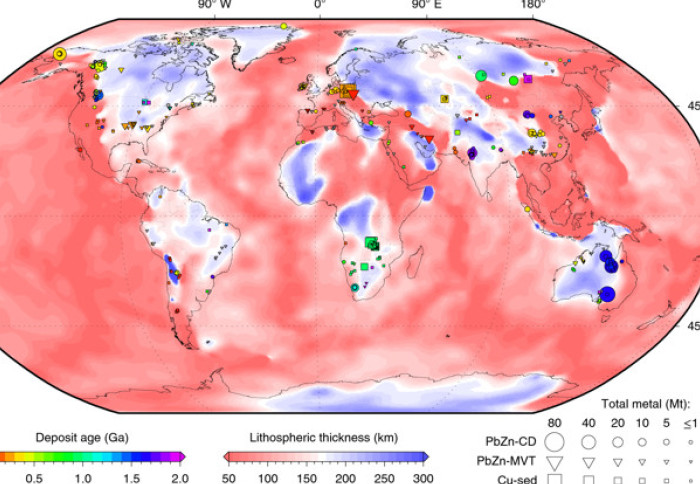Scientists find link between tectonic plate thickness and base metal deposits
by Helen Wilkes

Map of the earth showing lithosphere thickness. Circles, triangles and squares show known deposits of base metals.
Scientists have discovered a new link between the thickness of the Earth’s tectonic plates and large deposits of base metals.
Researchers from Imperial College London, Harvard University, Columbia University, Australian National University and Geoscience Australia have used statistical tests to compare the thickness of Earth’s tectonic plates (‘lithospheric thickness’) with the location of deposits of metals such as copper, lead and zinc.
They discovered that base metals are found most near to areas where lithospheric thickness is changeable regardless of the age of the deposit. The researchers say the findings could improve mining efficiency and lead to less environmentally destructive mining practices.
The paper is published in Nature Geoscience.
Base metals are important components of many of the electronic items we use in our daily lives, such as electrical wiring, batteries, and solar panels. Within 25 years, consumption of these materials is set to exceed the total produced in human history to date. Being able to pinpoint the location of these metals accurately will improve mining efficiency, allowing the discovery of new reserves rather than exploiting existing ones as well as replacing older, more destructive mining practices.
Research carried out in 2016 in Australia, a rich source of base metals, provided the starting point for this study which was then expanded to other similar locations across the world via a global database to confirm the findings. It showed that rifting of thick lithosphere causes a specific combination of deeper depressions (formed by the Earth’s lithosphere extending and then sagging) and the ideal amount of heat, allowing water circulation which encourages metal deposits to form. Base metal deposits formed in this way are highly desirable due to their higher metal content and ore quality.
The basins in which these deposits are found were formed by continental rifting, where the continental lithosphere extends, thins and sags. Over 85 per cent of base metals were found within 200 kilometers of the border between thick (>170 km) and thin lithosphere which outlines the edge of many of these basins.
Co-author of the paper Dr Fred Richards, from Imperial’s Department of Earth Science and Engineering, said: “This discovery may greatly narrow the search space for base metals which are used in a range of economically and environmentally critical applications. An additional advantage of finding new base metal deposits is that, compared to magmatic counterparts, they generally contain more metal bound up in higher grade ore, making the extraction and refining process much less environmentally damaging.
“Many of the ingredients required to form large sediment-hosted base metal deposits are common to all continental rift basins, which has led geologists to puzzle over why their distribution appears somewhat random within these regions. However, by mapping out the thickness of the tectonic plates that make up Earth’s lithosphere, we found that 85 per cent of all metal in these deposits, and 100 per cent of the “supergiant” deposits (> 10 million tonnes of metal), occur along the edge of regions with very thick (>170 km) lithosphere, known as cratons. When this thicker lithosphere is rifted to form these boundaries, our numerical models indicate that the ideal conditions are created for metal deposition, as the basin formed is particularly deep and the metal-bearing fluids within it remain relatively cold.”
Discussing the next steps for the research team, Dr Richards said: “Our research was recently used as a case study to successfully justify an A$125 million extension of Geoscience Australia’s Exploring for the Future program by the Australian Government. We hope to use this opportunity to work with our Australian colleagues to pinpoint sediment-hosted deposit locations more accurately and to develop economic potential maps by integrating other geophysical, geological and economic datasets into our framework. In particular, we’re keen to explore the potential of previously overlooked basins and also to investigate the implications of our work for other deposit types."
Hoggard, M.J., Czarnota, K., Richards, F.D. et al. Global distribution of sediment-hosted metals controlled by craton edge stability. Nat. Geosci. 13, 504–510 (2020). https://doi.org/10.1038/s41561-020-0593-2
Article text (excluding photos or graphics) © Imperial College London.
Photos and graphics subject to third party copyright used with permission or © Imperial College London.
Reporter
Helen Wilkes
Faculty of Engineering